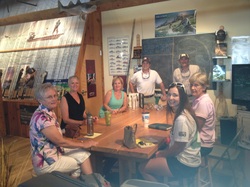
Several months ago, Kathy, one of the NCLA members, brought in a flyer with information on some fly-fishing classes being held at a local retailer in Ocala, Florida called Flint Creek Outfitters and expressed an interest in attending them. She wondered if anyone else would be interested in doing them too. Turned out she was right. That's when Trent Comer, from the Flint Creek Outfitters store, was invited to come and speak to the group to explain what fly-fishing was really all about. He attended the May 7th meeting and gave a nice presentation about some of the common misconceptions many people have about the difficulty of fly-fishing. Five of those ladies got together and set aside the afternoon of Saturday, July 13th and drove to the Ocala retailer to learn more about the sport of fly-fishing. Trent began with these words:
"Once you learn to fly-fish, you'll never use a spinning rod again!"
Introducing David Hulsey - Fly-Fisherman Extroidinaire
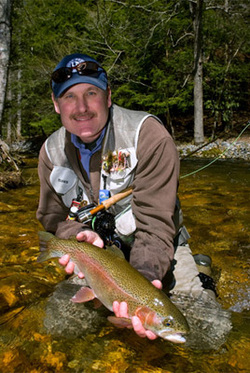
Trent had mentioned at the May meeting of the NCLA that a new fly-fishing instructor was coming on board the Flint Creek Outfitters organization and here he was in the flesh...David Hulsey.
David has seriously fly fished for over 40 years. He has pursued both fresh and saltwater species with a fly all over North America and has been a full time fly fishing guide and instructor for 20 years. He has guided in Georgia, North Carolina, and Wyoming. He is a year 2000 graduate of the Joan Wulff Fly Casting Instructors School, an International Federation of Fly Fishers Master Certified Fly Casting
Instructor and currently the Fly Fishing Manager and Fly Tying Instructor at Flint Creek Outfitters in Ocala Florida, also a published outdoor writer and photographer. Clearly, the ladies were in good hands!
David has seriously fly fished for over 40 years. He has pursued both fresh and saltwater species with a fly all over North America and has been a full time fly fishing guide and instructor for 20 years. He has guided in Georgia, North Carolina, and Wyoming. He is a year 2000 graduate of the Joan Wulff Fly Casting Instructors School, an International Federation of Fly Fishers Master Certified Fly Casting
Instructor and currently the Fly Fishing Manager and Fly Tying Instructor at Flint Creek Outfitters in Ocala Florida, also a published outdoor writer and photographer. Clearly, the ladies were in good hands!
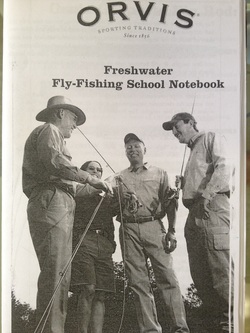
Sitting on the table in front of each stool was a 34 page fly-fishing manual that was used during class. All of the most important topics were covered in class by both Trent Comer and David Hulsey with the exception of a minor few. Trent gave the group firm instruction to guard the content of this booklet - in other words, don't go making copies of it and passing them around - as it holds some very valuable information that those who were in class paid for.

One of the very first things the group learned was that each Orvis manufactured fly rod was imprinted with the rod substance, length, weight, and recommended line weight for any specific species of fish being targeted. That made selecting a rod for beginners, like our girls, as simple as possible. Simple is Good!
Let's Talk About Rods
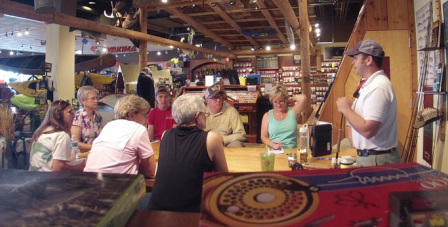
Trent, with his well-timed jokes and great sense of humor, began by explaining the difference between the most popular Orvis graphite rods and other specialty rods like split bamboo and spey rods. He made them laugh when he referred to anyone who asked for specifics on a topic as the "high achiever" in the class. They all ended up in the "high achiever" club by the time class was over. He answered questions like which fly rods were best for fresh and salt water, how to determine the strength of the rods when choosing one, and he enlightened them on the different hardware on the rods like stainless steel or anodized aluminum. He told them about flexible titanium rod guides and the resin used as a coating to protect it. Trent educated the ladies on the many rod length and weight options available to them and what the average rod length was for both fresh and saltwater fishing along with the line weight, again, depending on the targeted species. Everything, it seemed, depended on the targeted species!
Okay, Now Let's Talk About Reels
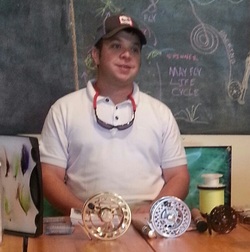
There was no time for bathroom breaks - before they knew it, the discussion from fly rod rolled right on over into reels without Trent skipping a beat. Reels, they learned, were just glorified line holders whether they were made of aircraft aluminum or plastic. He covered topics about the drag systems with adjustments inside the reel and those located on the outside. The girls learned new terms line "click & pull drag", "reel arbors", "stripping", and "palm the reel". Trent informed the group on the importance of arbor size and how it directly affects the angler's ability to retrieve a small fish or a large fish that will run with the line. Although many women will argue the eternal question about "size matters", in this case it truly does. He also answered one of the "high achiever's" question about which is the most important to sink money into - rod or reel. Trent's answer? Naturally it will "depend on the targeted species." How did they not see that coming?
Well What About Line...Let's Talk About Line
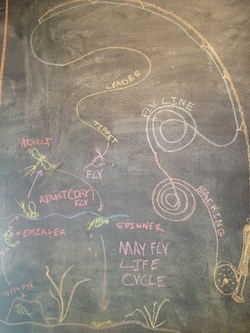
Good Lord - now things were about to get complicated. If they took a potty break now, they'd never be able to pick up where they left off. The ladies had gotten quite comfortable at jabbing jokes of their own throughout Trent's presentation. Trent had discussed most of the topics to this point. Now it was time to let David Hulsey do what he does best.. The next topic on the agenda, which was fly line, would be taught by David. They were drilled on back line, fly line, leader line, and tippet line and learned to differentiate between the four. Backline came braided and gel-spun. One allowed more line on the reel than the other. Also, the reel had printed recommendations on how much back and fly line it could hold. The majority of the line on the reel is, of course, fly line, which is weighted to allow for smooth casting, similar to the way a weighted jig-head allowed with a saltwater spinning combo. It was also revealed that fly line, if not handled carefully, had the tendency to cut into the skin so precautions should be taken for the newbies..
Let's Talk About Line Some More....
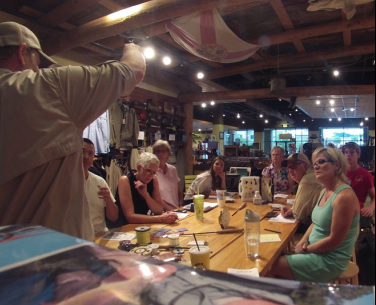
As if their brains weren't overloaded at it was - Dave continued on with more information on fly line. The group was schooled on the difference between straight and weight-forward fly line, and why one was more popular than the other. Dave taught them about the different line colors available, why they are produced in different colors and how to chose the right color - say it with me now..."depending on the targeted species." He explained that fly line comes in floating, intermediate, and sinking varieties and that 90% of sales are for floating line. Finally, regarding fly line, he pointed out and explained the four sections of the fly line: front taper, belly, rear taper and running line.
And Let's Just Keep Talking About Line
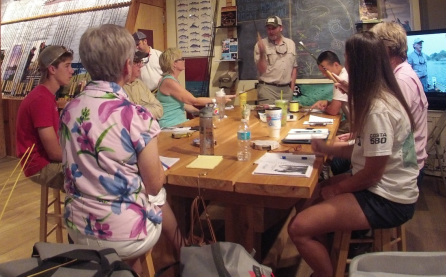
So... two basic fly lines had been covered in detail: backing and fly line. Still to come were two other lines necessary for successful fly fishing: leader and tippet line. Leader line for fly rods came in the same options as leader line for spinning rods, that being monofilament and fluorocarbon. Which to use was the question. Monofilament is cheap...er...inexpensive, and it's hollow so it floats easily. Fluorocarbon is more expensive (and we learned why) but it is clearer and a bit stronger so it sinks easier. Other leader options were brought up for those fish who can easily cut right through regular mono or fluorocarbon leader. The challenge is to select leader line that can go unnoticed to a fish's eye but strong enough to handle a large fish when it tackles the fly. Experience will perfect this ability. Lastly, Dave tackled tippet line and its role in the fly-line continuum. The tippet line is just an extension of the leader line and is used to supplement the leader line when it has been cut shorter than expected.
Surprise - Now We'll Talk About Knots
As the typical afternoon Florida thunderstorm dumped buckets of water outside the store, Dave distracted the ladies by redirecting their attention to the topic fo tying knots. He took them from tying an arbor knot to the reel, all the way to tying an Orvis knot to a fly lure. It went something like this:
- arbor knot - reel to backline
- perfection loop / nail knot - backline to fly line
- loop to loop connection - fly line to leader line
- barrel knot / triple surgeon's knot - leader to tippet
- Orvis knot / davy knot / improved clinch knot - tippet to fly
Oh, Those Cute Little Flies
In this world of mass production, it came as a pleasant surprise to learn that 100% of the flies being sold and used today are ALL carefully crafted by hand. Now...that takes time, creativity, skill, a desire for perfection, and patience. All of the women were quite impressed with the variety of flies that Trent had pinned to his little display board. It was amazing to see how realistic those lures really looked. They couldn't help but to touch & feel some of them. As they were being passed around for show-&-tell, Trent mentioned that the Clouser Minnow & Wooly Booger flies are the most popular of all and that Flint Creek Outfitters actually offers fly-tying classes every Monday evening from 5-7 p.m. That actually sounded like fun. Call the store for more details at 237-5325.
Casting Demonstrations
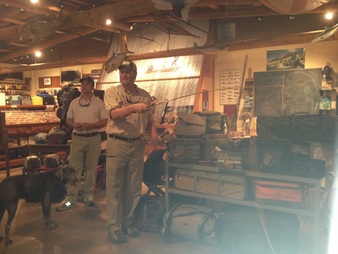
As it continued to rain outside, Dave escorted the ladies off of their stools and over to a long hallway in the store that would allow him to demonstrate some basic casting techniques. He made it much easier to understand how so much loose fly line could be easily controlled with the right arm movements. He went through several different basic techniques and repeated them over and over again so that the all of the ladies could get a good idea of the steps needed for a successful cast. As his presentation came to an end, so did most of the heavy down pour. It had eased up to a tolerable drizzle at that point and the girls were anxious to get outside and try their hand at fly casting themselves.
Let's Do This...

The rain had let up a little while the casting demo was going on inside and when that was over, it was time to let the group get a genuine feel for casting a fly rod. Dave and Trent escorted the girls outside, gave them each a fly rod with the reel already pre-loaded with fly line and leader. They followed Trent's instructions on stripping some of the line off of the reel before threading it through the guides. Once all of the rods had been properly threaded with line, Dave demonstrated the safest way to carry a fly rod while walking and watched as they all pointed their rod tips behind them and followed their leader to a large area of cut grass - perfect for casting practice.
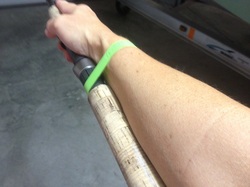
The instructors, knowing well in advance that most of those women came from saltwater spinning combo backgrounds, immediately bound the ladies' forearms to their fly rod so they wouldn't be able to use any reflex wrist-action due to old spinning combo casting habits. It was quite awkward but a necessary evil, they knew.
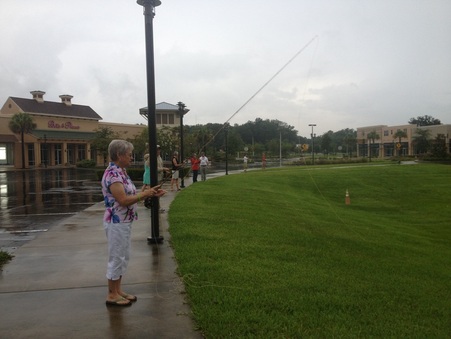
The next half hour was spent on casting practice. The girls spread themselves out and made sure they each had enough elbow room. Dave and Trent gave them all the go-ahead to start their attempts at casting so that they could immediately identify any potential problems. Most of the ladies started off having problems with the "10:00 & 2:00" rod-tip positions and waiting a second at the "10" position before making the forward motion to the "2" position. Once they got the hang of that, then their fly line was spooling off the reel like magic. They were surprised at how smooth the cast was and how far out in the distance the line ended up. Wow...this hands-on experience was a real eye-opener. It was easy to see, now, why so many people enjoy this style of fishing.
Leave 'Em Wanting More
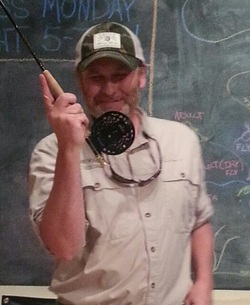
It was getting late and the ladies had tried their best to absorb every piece of information that both Dave and Trent shared over the course of the last few hours. From the chalkboard drawing, to the oral discussion to the visual examples and finally to the hands-on practice - it was a lot to take in. Nevertheless, this is what they came and paid for. Next on their agenda is to take this to the next level. They plan to meet back at the store in two weeks and go fly-fishing together at a local lake to try their skill in real time. We'll have to wait a little longer for that story. Thanks to Trent Comer and Dave Hulsey for putting up with a bunch of giggly women for three + hours - you both deserve a medal.
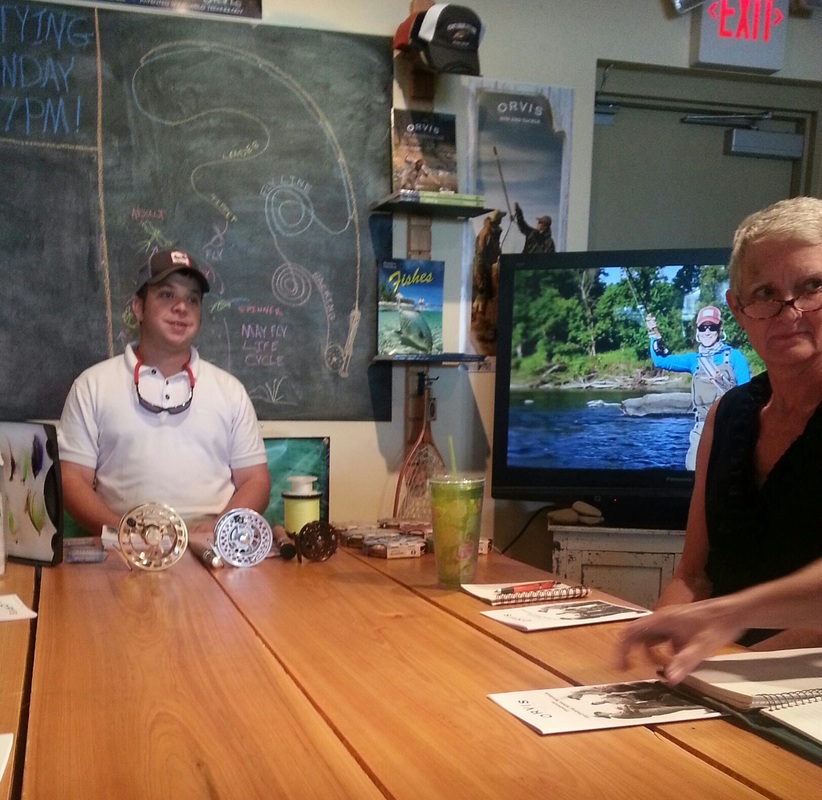
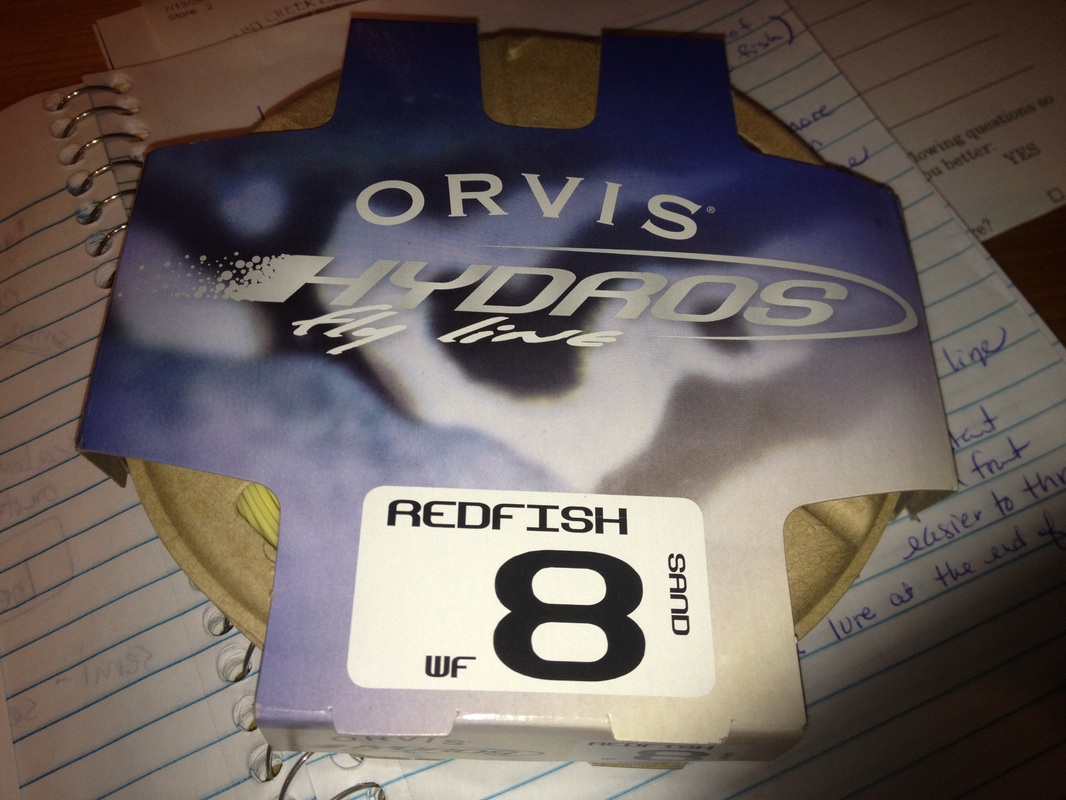
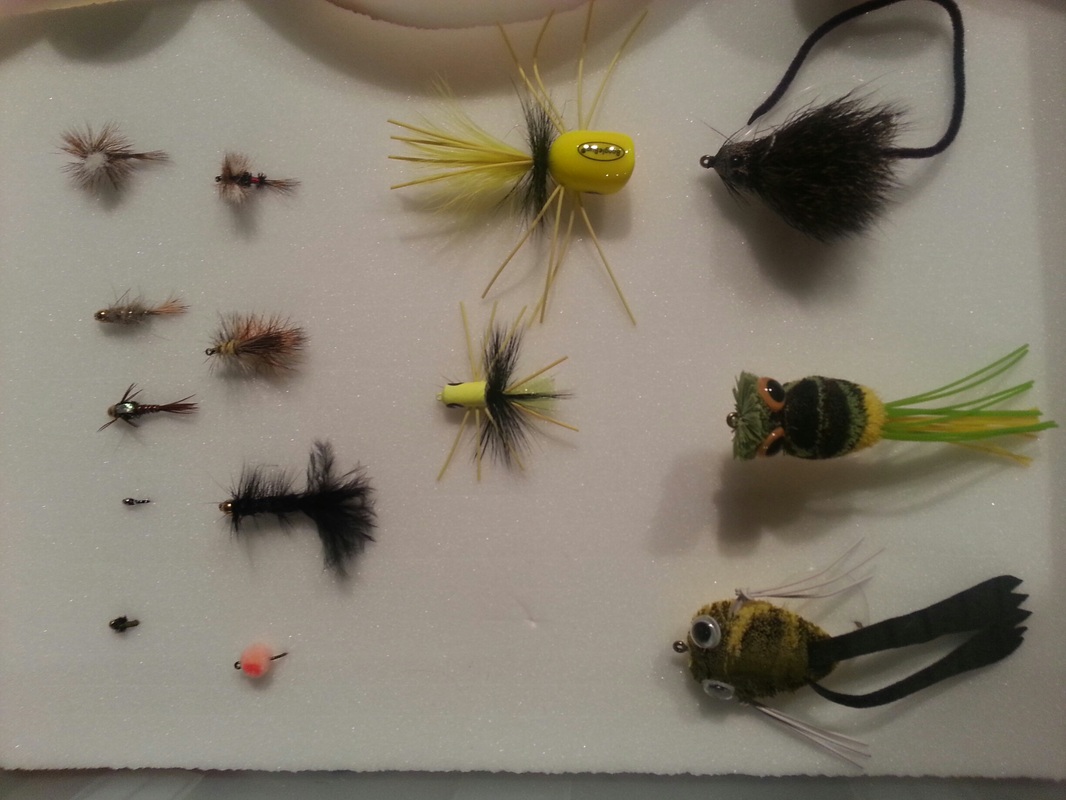
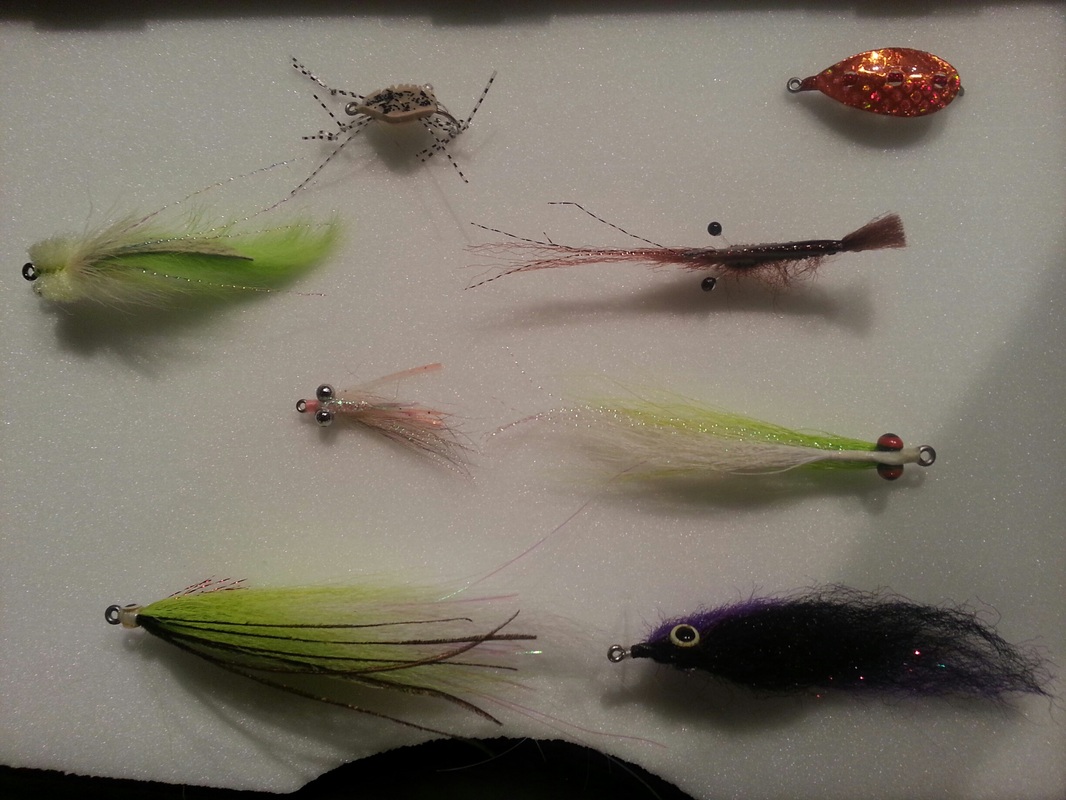
 RSS Feed
RSS Feed